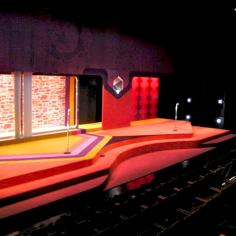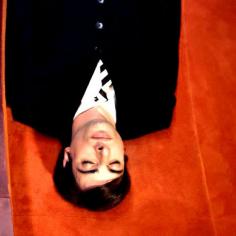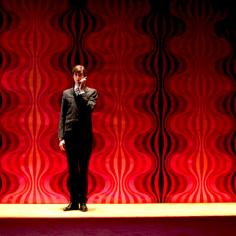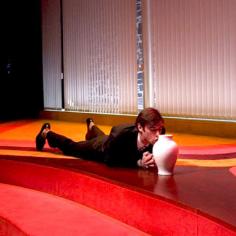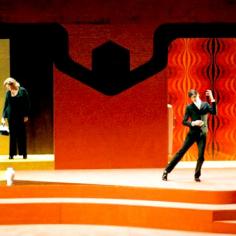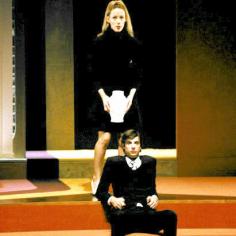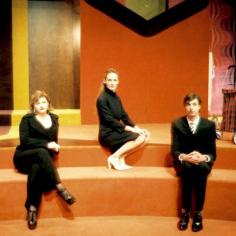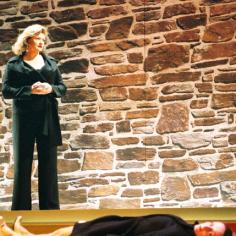2006 · Jusqu’à ce que la mort nous sépare · De Vos · Vigner (EN)
On 10 October 2006, Vigner created JUSQU’À CE QUE LA MORT NOUS SÉPARE by RÉMI DE VOS with CATHERINE JACOB, MICHA LESCOT and CLAUDE PERRON.
JUSQU’À CE QUE LA MORT NOUS SÉPARE (TILL DEATH US DO PART) is a black comedy for three truly infernal actors. It is also the story of a family, of a son who returns to his mother’s home with an urn that contains the ashes of his grandmother who has just been incinerated. This fairly tragic moment is the starting point for a comic action that unfolds inexorably with clockwork precision.
"I always start from the text, the story as such isn’t enough. I base my stage direction on a writing in the essence of which I can recognise myself … a way of breathing, a way of thinking, a sensibility, a special energy, some movement, that is what I want to share with others, as if I were giving a book to a friend."
ÉRIC VIGNER
"On the occasion of his grandmother’s death a man meets his mother again, whom he has not seen for several years. The meeting is not without problems, but it is also an occasion for him to see his early love again, whom he has never forgotten. Despite the hard words mother and son have for each other and an incident which might easily spoil it all, they ultimately reconcile. The play speaks of love, death and time as it passes inexorably (what else could it do, if you come to think of it?). It also speaks of lies, of hate, of longing and of madness - and many other things, which I just cannot recall. Ten years ago it was Eric who produced my first text and, in so doing, launched me on the road to become a playwright. So it is possible, after all, to meet with durable friendship. In today’s world of theatre, this really means a lot. And it urges one to go on writing."
RÉMI DE VOS
The aesthetics of the play is that of a boulevard comedy, very direct, and also of the nineteen sixties or eighties, inspired by American architecture with such things as orange wall-to-wall carpeting, straight lines, large picture windows, Venetian blinds and imitation stone walls.
"I was looking for a new form that would match this new way of writing. I did not want anything like a realistic setting, there is no décor for you to lean on, there are no walls. It is a space created for a specific purpose - or one no longer in use. The spectators cannot say whether they are there just before the performance is to start, or whether the play is over. Nor can one say whether what they see exists or doesn’t exist at all. I love these tragicomical stories very much, stories that leave you to a delicate equilibrium."
ÉV
"Recalling stylistic elements of pop culture and the shrill aesthetics of the seventies, the living room with its carpeted steps and the immense picture window giving onto a prospect made up of a tall stone wall, Eric Vigner’s décor is a jewel of humorous stage design."
PATRICK SOURD, Les Inrockuptibles, 9 January 2007
ANNE. The plastic bag !
SIMON. Hurry, hurry, hurry !
ANNE. Oh là là, oh là là...
They put the ashes and the fragments of the urn in the bag.
SIMON. Oh no, no, no !
ANNE. There’s still something on the floor. There! Hurry up!
SIMON. Where ? Where, for heaven’s sake ?
ANNE. There ! Do pick it up. Oh my God !
SIMON. Allright. Nothing left...
ANNE. So there. No, nothing left. Nothing at all, not a trace of it. Nada.
Simon looks about him.
SIMON. Where’s it, now ?? Where ?? Where’s the bag ?
ANNE. Where IS it ? Where ? Where ? [1]
Madeleine. Why did he give you the urn !
Anne. Why he gave it to me ?
Simon. The urn.
Anne. The urn ?
Simon - If you please.
Anne looks at Simon.
Anne. If you please what ??
Madeleine. But this is something after all !
I want to know why he gave it to you.
Anne looks at Madeleine.
Anne. Because we were going to get married.
Simon looks at Anne.
Madeleine. Good Lord. [1]
"When meeting his mother again, Simon finds himself confronted with a numbed, frozen world from which there is no escaping. Trapped, this young man, who succeeded outside his former home, leaves messages on the answering machine of his office colleagues as a shipwrecked might toss bottles into the sea. He is physically fettered, tied to the lineage of women around him, and his mobile is his only hope. Simon returns to his origins, into the womb as it were. To save himself he invents a story - a situation he had always been careful to avoid. As in a Pinter play, what one sees is only the bubbles that rise from the bottom of the sea, the tip of the iceberg. What is below the water line is for the spectator to reconstruct."
ÉV
For his text of JUSQU’À CE QUE LA MORT NOUS SÉPARE, RÉMI DE VOS was awarded the Prix Théâtre 2006 of the Fondation Diane & Lucien Barrière, which was handed to him on the occasion of the performances at the Théâtre du Rond-Point in Paris in January 2007.
© Photography : Alain Fonteray, Frédéric Nauczyciel
Texts assembled by Jutta Johanna Weiss
Translation from the French by Herbert Kaiser
© CDDB-Théâtre de Lorient
